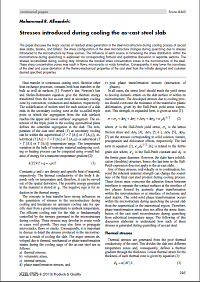This paper discusses the major sources of residual stress generation in the steel microstructure during cooling process of as-cast steel (slabs, blooms, and billets). The stress configuration of the steel microstructure changes during quenching due to stresses introduced to the microstructure by these sources. The influence of each source in increasing the stress distribution within the microstructure during quenching is explained via corresponding formula and qualitative discussion in separate sections. The stresses accumulated during cooling may introduce the residual stress concentration zones in the microstructure of the steel.
These stress concentration zones may result in flaws, microcracks or voids formation. Consequently, it may lower the soundness of the steel and cause deviation of the thermo-mechanical properties of the cast steel from the initially designed and customer desired specified properties.
Stresses introduced during cooling the as-cast steel slab

